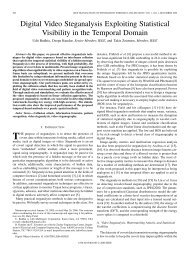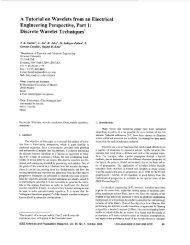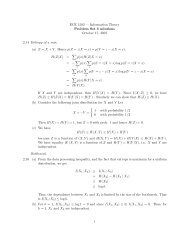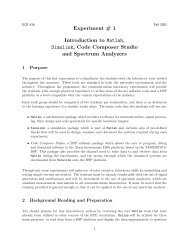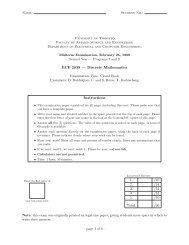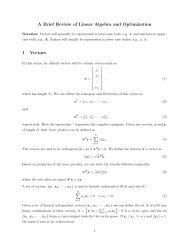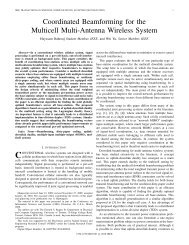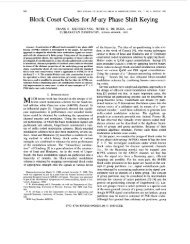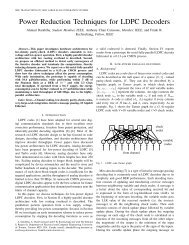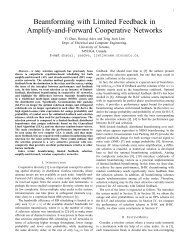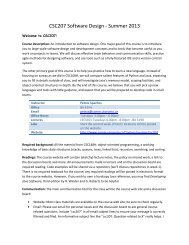bloom filter based intrusion detection for smart grid scada
bloom filter based intrusion detection for smart grid scada
bloom filter based intrusion detection for smart grid scada
You also want an ePaper? Increase the reach of your titles
YUMPU automatically turns print PDFs into web optimized ePapers that Google loves.
BLOOM FILTER BASED INTRUSION DETECTION FOR SMART GRID SCADASaranya Parthasarathy and Deepa KundurDepartment of Electrical & Computer EngineeringTexas A&M UniversityCollege Station, TX 77843 USAABSTRACTIn this paper, we propose a distributed, light-weight and fast<strong>intrusion</strong> <strong>detection</strong> approach suitable <strong>for</strong> implementationacross multiple resource constrained SCADA field devicesin the <strong>smart</strong> <strong>grid</strong>. The predictable and regular nature of theSCADA communication patterns is exploited to detect<strong>intrusion</strong>s in the field devices. The novel approach isanomaly-<strong>based</strong>, uses the Bloom <strong>filter</strong> data structure <strong>for</strong>memory efficiency and incorporates the physical state of thepower system <strong>for</strong> greater robustness. The proposed methodis tested using MODBUS protocol used <strong>for</strong> communicationbetween a SCADA server and field devices in a SCADAsystem.Index Terms— Bloom <strong>filter</strong>, <strong>intrusion</strong> <strong>detection</strong>, <strong>smart</strong><strong>grid</strong> SCADA IDS.1. INTRODUCTIONSupervisory control and data acquisition (SCADA)systems are industrial control systems responsible <strong>for</strong>distributed monitoring, control, collection and analysis ofreal-time data. Vulnerabilities in these systems haveheightened in the recent years and are envisioned to furtherescalate (notably when used in power systems) <strong>for</strong> severalreasons. The SCADA communication networks areincreasingly interconnected with corporate in<strong>for</strong>mationtechnology (IT) networks <strong>for</strong> the collection and processingof data in real-time providing greater opportunity <strong>for</strong><strong>intrusion</strong>. Most SCADA devices such as remote terminalunits (RTUs), programmable logic controllers (PLCs) andintelligent electronic devices (IEDs) do not incorporateauthentication or encryption mechanisms; moreover, remoteaccess to these devices via technologies like Bluetooth andWi-Fi has been made available increasing the risk of exploit.In addition, typical protocols used <strong>for</strong> SCADAcommunications are proprietary meant <strong>for</strong> dedicated serialcommunication and hence do not possess basic securityservices. These protocols have been recently modified <strong>for</strong>use over Ethernet, in turn increasing access points and riskof compromise.Hence recently there has been growing interest inSCADA security. Recent attacks involving the Stuxnetworm have also increased activity. The main goal of Stuxnetis to sabotage industrial equipment controlled by a specificSiemens PLC by modifying the PLC code and then hidingthe changes using root kits. Such worms can cause severedamage to the underlying physical system. Thus there hasbeen an increasing need to incorporate security combinedwith <strong>intrusion</strong> <strong>detection</strong> and mitigation in <strong>smart</strong> <strong>grid</strong>SCADA components.There are challenges to developing <strong>intrusion</strong> <strong>detection</strong>systems (IDSs) specific to SCADA that, in part, stem fromthe differences between SCADA and traditional IT systems:• Availability and timeliness are critical; hence the CIA(confidentiality-integrity-availability) design mantra inIT systems trans<strong>for</strong>ms to AIC (availability-integrityconfidentiality)<strong>for</strong> SCADA systems.• There exists limited memory and computing resourcesin SCADA field devices such as PLCs, RTUs.• There is cyber-physical coupling between the SCADAsystem and underlying power <strong>grid</strong>. Moreover, attackson SCADA can have devastating cascading effects onthe underlying physical system.The objective of this paper is to propose a new lightweight<strong>intrusion</strong> <strong>detection</strong> approach suitable <strong>for</strong>implementation in components like RTUs, PLCs withlimited computational resources. The approach takes intoconsideration the a<strong>for</strong>ementioned distinctions. We leveragethe properties of a data structure called the Bloom <strong>filter</strong>,which represents a set of data in concise <strong>for</strong>m suitable <strong>for</strong>characterizing the set of normal communication trafficpatterns in power system SCADA. The normal behaviorestablished using the Bloom <strong>filter</strong> is used to per<strong>for</strong>m fastO(1) lookups during online <strong>intrusion</strong> <strong>detection</strong>. Theapproach takes into account the physical state of the powersystem in relation to the SCADA traffic.Section 2 reviews related work in the field of SCADAspecific<strong>intrusion</strong> <strong>detection</strong>; we also explain the MODBUSprotocol used <strong>for</strong> SCADA communications. Section 3presents the SCADA system architecture considered and ourproposed methodology <strong>for</strong> Bloom <strong>filter</strong>-<strong>based</strong> <strong>intrusion</strong><strong>detection</strong>. Section 4 details our implementation whileSection 5 highlights insights gained and offers futureresearch directions.2. RELATED WORKIDSs can be classified into two main categories: misuse<strong>based</strong>and anomaly-<strong>based</strong> [1]. Misuse-<strong>based</strong> approaches2012 25th IEEE Canadian Conference on Electrical and Computer Engineering (CCECE)978-1-4673-1433-6/12/$31.00 ©2012 IEEE
employ known attack patterns to construct signatures thatare represented as rule sets using languages such as Snort.Incoming traffic is compared against these rules todetermine whether traffic is normal or corresponds to anattack. The improved per<strong>for</strong>mance <strong>for</strong> known attacks comesat the cost of lack of support <strong>for</strong> novel attacks. In contrast,anomaly-<strong>based</strong> methods employ system data to create“normal” behavioral profiles during a training phase andthen flag deviant profiles during <strong>intrusion</strong> <strong>detection</strong>. Theability to detect new attacks trades-off with often-higherfalse alarm rates. Researchers have recently studied thesuitability of these approaches <strong>for</strong> SCADA communications.In [2] a misuse-<strong>based</strong> <strong>intrusion</strong> <strong>detection</strong> and eventmonitoring approach to address unauthorized access toSCADA devices is presented. Details about each SCADAdevice such as IP address, telnet port, and legal commandsare expressed using XML. A Perl program parses this XMLand creates Snort signatures that are used to detect attacksoffline. The authors of [3] propose a specification-<strong>based</strong>multi-IDS algorithm <strong>based</strong> on a <strong>for</strong>mal model of theunderlying MODBUS/TCP, which also uses Snort rules toanalyze violations in communication patterns. There alsoexist misuse-<strong>based</strong> commercial MODBUS <strong>filter</strong>ing moduleslike Cisco’s Net <strong>filter</strong> [4].In [5] an anomaly <strong>detection</strong> method <strong>for</strong> SCADA systems<strong>based</strong> on features including network traffic, link utilizationand CPU usage is proposed. The feature vector is fed asinput to an auto associative kernel regression model thatpredicts the correct versions of the inputs. Residuals are<strong>for</strong>med by comparing the observed input values with themodel predictions. A binary hypothesis technique called thesequential probability ratio test is applied to the residuals todetermine whether the residuals correspond to a normal orabnormal distribution. In [6], a test bed is developed tosimulate a SCADA client, server and power <strong>grid</strong>. Theauthors propose an autonomic software protection systemthat has rules to analyze MODBUS requests/responses. Thissystem selectively drops packets to protect SCADA systemsfrom flooding and denial-of -service (DOS) Attacks.Many IDS systems <strong>for</strong> SCADA and the MODBUSprotocol are centralized and focus on <strong>intrusion</strong> <strong>detection</strong> ateither the SCADA master or server. In this paper, wepropose a distributed approach that extends <strong>intrusion</strong><strong>detection</strong> to field devices including RTUs and PLCs.Moreover, we address <strong>detection</strong> by leveraging MODBUSpayload parameters embedded within the TCP packet. Thisenables our IDS to take on a more contextual flavor. This isachieved by taking into account the relationship amongstadjacent MODBUS packets (as opposed to consideringisolated packets <strong>for</strong> <strong>detection</strong>) and incorporating the cyberphysicalcouplings in the power system by incorporatingknowledge of the physical state of the power system.2.1. MODBUS ProtocolThe MODBUS protocol has been the industrial standard<strong>for</strong> communication among automation and control devicessince 1979. Originally designed <strong>for</strong> serial communication, ithas been modified to run over Ethernet residing at theapplication layer (level 7) of the OSI model. It enablesclient/server communications between devices connected ondifferent types of networks by employing a master-slavemethod at the message level but peer-to-peer at the network.The master (or client) initiates the transactions with theslave devices (or servers) by sending requests; the slavesrespond to the requests by per<strong>for</strong>ming the requested actionand sending a response message. The query from the masterusing the MODBUS protocol consists of the device address,a function code corresponding to the action requested, anydata to be transmitted, and an error–checking field. Theslave’s response message constructed using MODBUScontains fields confirming the action taken, any data to bereturned, and an error–checking field. The function codetogether with the data is called a protocol data unit (PDU)and is the entity used by our proposed <strong>intrusion</strong> <strong>detection</strong>mechanism.3. PROPOSED APPROACHThe architecture we consider is a typical SCADAmaster-slave configuration as shown in Figure 1.Figure 1. SCADA Master-Slave Configuration.The main components are the human-machine interface(HMI) at the operator workstation, the SCADA master (alsocalled SCADA server), field devices such as RTUs andPLCs and their associated communication infrastructure.The communications between the SCADA master and fielddevices are assumed to follow the MODBUS protocol.3.1. Threat ModelWe focus on developing an IDS <strong>for</strong> external targetedattacks. The reader should note that we do not considerinsider attacks nor coordinated distributed attacks. Theattack scenarios that fall under this threat model include:
1. HMI compromise, in which the attacker hascompromised the HMI and can send commands toSCADA components to destabilize the <strong>grid</strong>. CommonHMI commands in a power systems include read bus linestatus, read trans<strong>for</strong>mer status, read/change magnitudeand phase angle of the bus, and open/close circuitbreakers. While the attacker can manipulate thesecommands as per his attack objectives, he can also makesure that the display at the operator interface does notconvey the actual state of the system to stakeholders.2. Man-in-the-middle attack, which involves interceptingcommunications between the SCADA server and fielddevices, sending spoofed packets to them. The attackercan employ this to per<strong>for</strong>m illegal writes to coils orregisters and even to restart MODBUS servers.3.2. MethodologyOur proposed approach <strong>for</strong> detecting such attacks is<strong>based</strong> on the intuition that the a<strong>for</strong>ementioned attacksmanifest as anomalies in the MODBUS request/responsetraffic patterns. Employing an anomaly-<strong>based</strong> approachrequires identification of “normal” behavior and comparingto it. To establish the normal profile, parameters such as thefunction code and data extracted from the MODBUSrequest/response patterns are used. This process can berepresented in two steps:I. Data Extraction, which involves extracting theMODBUS PDU in<strong>for</strong>mation (function code and data) fromthe communication traces between the MODBUS server andthe field devices using n-gram analysis. This requiresextraction of contiguous sequences of 'n' items using asliding window. The size of the window is dependent on thenature of traffic. For example, say, the MODBUS functioncodes in the five contiguous requests are 1, 5, 5, 1, and 5respectively; n-gram analysis to extract the function codesusing a sliding window of length five yields 15515.II. Training and Detection, which is detailed next. Thetraining data is obtained during phases of SCADAoperation. The associated MODBUS function codes anddata such as coil addresses from this training set are subjectto n-gram analysis and then are represented in a compressed<strong>for</strong>m via a Bloom <strong>filter</strong>.3.2.1. The Bloom <strong>filter</strong>The Bloom <strong>filter</strong> is a probabilistic memory-efficientalternative data structure to the traditional look up hash. Itcan be used to compactly represent a set of input values viatwo components: a set of k independent hash functions h 1 ,h 2 … h k with range {1, 2… m} and an m-bit vector v.Let S represent the set of all valid n-grams duringtraining, a representative sample of all n-grams duringcorrect SCADA operation. Consider an n-gram s={s 1 , s 2 , s n }of n elements given as input to the Bloom <strong>filter</strong>. Suppose h 1 ,h 2 … h k and v are all initialized to zero. To “insert” anelement s S into the vector v during training, it is hashed ktimes with h 1 , h 2 … h k to produce a string of k values eachranging from 1 to m which we denote as {h 1 (s), h 2 (s)…,h k (s)}. Next the bits in v at the indices corresponding {h 1 (s),h 2 (s)…, h k (s)} are set to 1. A particular bit may be set to 1multiple times by different inputs; thus an element of v setto 1 always stays 1.To test whether an element b exists in the set S, theelements of v at positions {h 1 (b), h 2 (b)…, h k (b)} arechecked to see if they are all marked one; if any one of thesek bits is zero, b is assumed not to exist in S. Otherwise, it ispossible that b S with finite probability.In our IDS approach, the Bloom <strong>filter</strong> is used tocompactly characterize the sequence of function codes anddata obtained during n-gram analysis of the MODBUStraining data set. During <strong>detection</strong>, the n-grams obtainedduring SCADA communications are passed through the<strong>filter</strong>; if the outputs, obtained after hashing all point toelements in vector v that are marked 1, the tested patternmay be non-anomalous. Otherwise it is not in S.3.2.2. Bloom <strong>filter</strong> parametersThere is a trade –off between memory requirements (m) ofthe Bloom <strong>filter</strong> and the false positive rate. The falsepositive rate can be tuned through choice of parameters mand k. According to [8], the probability of a false positive isminimized when the parameters are chosen according to therelation k= ln(2)×(m/n) where n is the size of the input dataset. The choice of hash functions employed affects thecollision rate and hence the false positive rate. A collisionoccurs when two inputs in S hash onto the same index ofvector v. The hash function used should produce minimalcollisions <strong>for</strong> this training set. Ideally, the hashes should beindependent and uni<strong>for</strong>mly distributed so that the output isequally distributed over the hash space. Unlike somecryptographic hashes such as MD5 and SHA1 the hashfunctions chosen should be light-weight. After analyzing thesuitability of various hash functions shown in the Table 1,the Murmur hash was chosen <strong>for</strong> our implementation.Hash functionFNVSAXJenkinsMurmurPros and ConsPros: FastCons: Higher falsepositives <strong>for</strong> our dataPros: Simple and fastCons: High collision ratePros: Less collision rateCons: Complicated andsuitable <strong>for</strong> light weightFast, light weight,produces minimalcollisions <strong>for</strong> our dataTable 1 Comparison of hash functions.3.2.3. Advantages
There are several advantages to the Bloom <strong>filter</strong>.Lookups and insertions are of order O(1). The data structurecan be dynamically updated easily as more data becomesavailable as adding an element involves hashing and settingan element in an array. False positive rates can be adjustedby the choice of hash function used and other Bloom <strong>filter</strong>parameters. The Bloom <strong>filter</strong> is space-efficient compared toother data structures like arrays, linked lists and hash tablesand is used in many network applications.3.2.4. Anomaly-<strong>based</strong> <strong>detection</strong> via the Bloom <strong>filter</strong>The Bloom <strong>filter</strong> is used during an initial offline trainingphase and when in online <strong>detection</strong> mode <strong>for</strong> anomaly-<strong>based</strong><strong>detection</strong>. During training, the function code and dataparameters are extracted from the offline data and stored intwo different Bloom <strong>filter</strong>s as shown in the Figure 2.In our current approach, the scores from both the <strong>filter</strong>s areequally weighted at 0.5. However these weights can bevaried when more parameters are added.3.2.4. Including Physical In<strong>for</strong>mationOur approach takes into account the communicationpatterns within the SCADA network. However as thesepatterns are strongly correlated with the physicalin<strong>for</strong>mation in the power system, we assert that an approachto incorporate the physical state would improve robustness.The operating states of a power system shown in theFigure 4. In the normal state, existing generators can servethe total load without violation of operational constraints.Examples of some operational constraints include limits ontransmission line flows and voltage magnitudes.Figure 2 Training phase. The n-grams <strong>for</strong> function codes andassociated data are separated and fed into two different Bloom<strong>filter</strong>s. The output of each <strong>filter</strong> is a binary vector v.During <strong>detection</strong>, the same parameters areextracted from the live MODBUS request/response patternsand then hashed. Lookup is per<strong>for</strong>med against the Bloom<strong>filter</strong>s constructed during training as shown in the Figure 3.Each <strong>bloom</strong> <strong>filter</strong> assigns a score to the pattern testedindicating the probability of anomalous behavior and theweighted sum from various Bloom <strong>filter</strong>s is the finalanomaly score.Figure 3 Detection phase. The hash outputs corresponding tothe live traffic are compared to the Bloom <strong>filter</strong> vectorsestablished during training.Figure 4 State Diagram <strong>for</strong> Power System Operation.In the emergency operating state, though someoperational constraints are violated, the power system stillsupplies power to all the loads. In this state, the systemoperator takes corrective measures to bring the system backto the normal state. The corrective measures can includedisconnecting loads, lines, and opening and closing ofbreakers. If these measures rectify the operating limitviolations and stabilize the system with a reconfiguredtopology, load versus generation balance has to be restored<strong>for</strong> the system to supply all loads once again. This state isknown as the restorative state. Hence the set of SCADAactions per<strong>for</strong>med by the system operator vary according tothe operating states of a power system, which in turn affectsthe way in which normal and abnormal behavior is defined<strong>for</strong> the MODBUS under different physical states.For example, the function code 0x01 in MODBUScorresponds to the “Read Coils” operation. This commandalso restarts the device and runs start-up tests. Seeing thisfunction code frequently within a time window may beabnormal under normal system state. However, represents avalid operation under emergency state. If the <strong>intrusion</strong><strong>detection</strong> system does not take this physical state intoaccount while assigning an anomaly score to the testedcommunication pattern, normal traffic would be assigned ahigher anomaly score. This results in higher false positives.
This necessitates the inclusion of power system statein<strong>for</strong>mation <strong>for</strong> <strong>intrusion</strong> <strong>detection</strong>.The question naturally arises as to how easily an attackercan compromise the state in<strong>for</strong>mation in IDS. The physicalstate is typically estimated using a process called stateestimation in SCADA. According to [9], if a power systemhas l measurement devices and r state variables, anadversary needs to compromise at least l-r+1 measurementsto ensure that he can falsify state estimation. However l-r+1is usually large <strong>for</strong> practical power systems. Even an IEEE300-bus test system has l-r+1 =824 devices that must becompromised thus creating an impractically high degree ofdifficulty <strong>for</strong> the attacker especially in light of our threatmodel.4. EXPERIMENTAL RESULTSThe software used <strong>for</strong> our implementation is Wire shark,a network protocol analyzer and C++. The data obtainedfrom sources [7] and at www.pcapr.net were analyzed usingWire shark. The n-gram analysis, creation of Bloom <strong>filter</strong>during training and anomaly <strong>detection</strong> were implementedusing C++. The data <strong>for</strong> training is <strong>based</strong> on the MODBUSregister and command assignments in [7]. Preliminary datais taken from [7] and some similar patterns are created to beused as the training data. The MODBUS function codes andthe data like coil addresses from this training set are subjectto n-gram analysis.In our simulations after per<strong>for</strong>ming n-gram analysis,parameters k and n of the Bloom <strong>filter</strong> were varied and theresults obtained are shown in Tables 2 and 3. The readershould note that it is well known that false negatives are notpossible in a Bloom <strong>filter</strong> whereas the false positive rate canbe adjusted via parameter tuning. However, Tables 2 and 3show the reverse due to a shift in interpretation. The falsenegative of the <strong>bloom</strong> <strong>filter</strong> corresponds to false positive ofthe overall IDS. This can be explained as a false negative inthe Bloom <strong>filter</strong> is equivalent to saying “a particularsequence is not valid when it is actually valid”. This is notpossible because if the sequence is valid and is included inthe training data set, it would be represented in acompressed <strong>for</strong>m in the <strong>bloom</strong> <strong>filter</strong>. Hence any normalpattern represented by the <strong>filter</strong> during training will not beclassified as anomalous during <strong>detection</strong>. In other words, thesystem cannot have false positives with proper training dataset. The results are in accordance with this fact.In a similar manner, the false positive rate of the <strong>bloom</strong><strong>filter</strong> corresponds to the false negative rate of the overallIDS. We can also infer that there is a decrease in the falsenegative rate when k is increased from 2 to 4 after whichthere is no improvement. Hence it is sufficient to have 4independent hash functions to achieve nominal <strong>detection</strong> <strong>for</strong>the chosen data. The parameter ‘m’ was calculated using the<strong>for</strong>mulak= (ln 2) *(m/n). For example, when k=4, m= (n*k)/ (ln 2) =(100*2)/ (ln 2) = 580 which is the size of the <strong>bloom</strong> <strong>filter</strong>.Value of k 2 4 6m (size of the Bloom <strong>filter</strong>) 289 580 870No. of bits set in v after training 202 404 606False positive rate (normal 0 0 0pattern classified as anomalous)False negative rate (anomalous 6% 2% 2%is classified as normal)Table 2: Per<strong>for</strong>mance by varying k.From Table 3, it can be observed that there is a decreasein the false negative rate when n is increased from 100 to200. But when it is increased beyond 200 there is noimprovement in false negative rate.Value of n 100 200 500m (size of the Bloom <strong>filter</strong>) 580 1159 2899No. of bits set in v after training 402 799 2000False positive rate (normal 0 0 0pattern classified as anomalous)False negative rate (anomalous 2.4% 0% 0%is classified as normal)Table 3: Per<strong>for</strong>mance by varying n.Hence a training data set of size n=200 with k=4different hash functions were chosen and the <strong>intrusion</strong><strong>detection</strong> algorithm was tested. A representative output ofthe IDS is shown in the trace below:Testing function sequence: 53523The tested function sequence may exist in the training setcumulative Anomaly Score=0Testing function sequence: 55555 Data sequence: 0000000000The tested function sequence does not exist in the training setcumulative Anomaly Score=0.5Testing function sequence: 55555 Data sequence: 00FF00FF00The tested function sequence does not exist in the training setcumulative Anomaly Score=1.0Testing function sequence: 15151The tested function sequence does not exist in the training setcumulative Anomaly Score=0.5It can be seen that the anomaly score can be different<strong>for</strong> the same sequence of function calls (55555) dependingupon the data. This is because a function code of “5”corresponds to read coils and the pattern of alternating 00and FF correspond to alternating coil ‘ON’ and ‘OFF’ whichis more suspicious. Hence this pattern gets a higher anomalyscore. The function code sequence 15151 corresponds to“Read Coil- Write Coil- Read Coil-Write Coil-Read Coil”.As the command “read coil” restarts the device and runssome start-up tests, occurrence of this pattern quitefrequently within a time window is classified as anomalous.The same pattern is not anomalous under “emergency”conditions of the power system as can be seen in the outputtrace below:
Testing function sequence: 53523The tested function sequence may exist in the training setcumulative Anomaly Score=0Testing function sequence: 55555 Data sequence: 0000000000The tested function sequence does not exist in the training setcumulative Anomaly Score=0.5Testing function sequence: 15151The tested function sequence may exist in the training setcumulative Anomaly Score=0When training was done using normal data, thesequence 15151 was given an anomaly score of 0.5 andwhen trained using emergency data, the same sequence wasgiven an anomaly score of 0. Hence without the knowledgeof physical state of the system, it is not possible to ascertainthe correct anomaly score. When in<strong>for</strong>mation regarding thephysical state of the power system is available, the resultschange as shown below:If the current state of the power system is “normal”, then the resultsbecomeTesting function sequence: 15151The tested function sequence does not exist in the training setstate=normalcumulative Anomaly Score=1If the current state of the power system is “emergency”, then the resultsbecomeTesting function sequence: 15151The tested function sequence does not exist in the training setstate=emergencycumulative Anomaly Score=0When the knowledge of the physical state is available, theanomaly score can be picked according to the statein<strong>for</strong>mation as shown in the output. Hence knowledge ofphysical state of the power system improves the accuracy ofthe <strong>intrusion</strong> <strong>detection</strong> system.During execution of this algorithm, input data sets ofsize 100, 1000 or greater than 1000 had an execution time oftime in the order of a few milliseconds. This demonstratesthat the time complexity of the algorithm is almost constant<strong>for</strong> various training input sizes demonstrating an advantageof Bloom <strong>filter</strong> approach.5. CONCLUSION AND FUTURE WORKA Bloom <strong>filter</strong>-<strong>based</strong> <strong>intrusion</strong> <strong>detection</strong> approach <strong>for</strong>resource constrained SCADA field devices is proposed andtested on SCADA traffic using the MODBUS protocol. Thenovel components of the system include the use of Bloom<strong>filter</strong>-<strong>based</strong> n-gram analysis as well as the physical state ofthe in<strong>for</strong>mation. We have observed that the Bloom <strong>filter</strong> hasthe following advantages over other data structures <strong>for</strong>incorporation in a SCADA distributed IDS:• low memory requirements;• zero IDS false positive rates ;• anonymity as the Bloom <strong>filter</strong> does not storein<strong>for</strong>mation direction unlike other data structures.The proposed approach has been tested with andwithout the knowledge of the power system state. We caninfer from our results that knowledge of the physical statehelps to reduce false positives. Moreover, the approach isdistributed across field devices such as PLCs and RTUs,hence the IDS can be partially operational even if few fielddevices are compromised.Future work involves identifying effective measures toaggregate individual alerts raised by local device IDSs. Inaddition, testing the approach <strong>for</strong> greater attack scenariosvia implementation in a test bed with power systemcomponents will be considered as part of our future work.6. REFERENCES[1] P. Ning and S. Jajodia, “Intrusion Detection Techniques,” inThe Internet Encyclopedia, H. Bidgoli, ed., John Wiley & Sons,December 2003.[2] B. Zhu, and S. Sastry, “SCADA-specific IntrusionDetection/Prevention Systems: A Survey and Taxonomy,” inProceedings of the 1st Workshop on Secure Control Systems(SCS), CPSWeek 2010, Stockholm, Sweden, April 2010.[3] S. Cheung, B. Dutertre, M. Fong, U. Lindqvist, K. Skinner andA. Valdes, “Using Model-<strong>based</strong> Intrusion Detection <strong>for</strong> SCADANetworks,” in Proceedings of the SCADA Security ScientificSymposium, Miami Beach, FL, January 2007.[4] V. Pothamsetty and M. Franz, Transparent Modbus/TCPFiltering with Linux. Available online:http://modbusfw.source<strong>for</strong>ge.net/. Last access 12/30/2011.[5] D. Yang, A. Usynin and J.W. Hines, “Anomaly-BasedIntrusion Detection <strong>for</strong> SCADA Systems,” in Proceedings of the5 th International Topical Meeting on Nuclear PlantInstrumentation, Control and Human Machine InterfaceTechnologies (MPIC&HMIT 05), Albuquerque, NM November2006.[6] M. Mallouhi, Y. Al-Nashif, D. Cox, T. Chadaga and S. Hariri,“A Testbed <strong>for</strong> Analyzing Security of SCADA Control Systems(TASSCS),” in Proceedings of the 2011 IEEE PES InnovativeSmart Grid Technologies (ISGT), Anaheim, CA, January 2011.[7] S. Cohen, W. Sherman, and M. Sherman, “MODBUS/TCPController <strong>for</strong> the Power Supplies in ALS BTS Beam Line,” inProceedings of the IEEE Particle Accelerator Conference (PAC),Albuquerque, NM, June 2007.[8] Y. Al-Nashif, A.A. Kumar, S. Hariri, Y. Luo, F. Szidarovskyand G. Qu, “Multi-Level Intrusion Detection System (ML-IDS),”in Proceedings of the International Conference on AutonomicComputing (ICAC), Chicago, IL, June 2008.[9] R.B. Bobba, K.M. Rogers, Q. Wang, H. Khurana, K. Nahrstedtand T.J. Overbye, “Detecting False Data Injection Attacks on DCState Estimation,” in Proceedings of the First Workshop on SecureControl Systems (SCS), CPSWeek 2010, Stockholm Sweden, April,2010.



